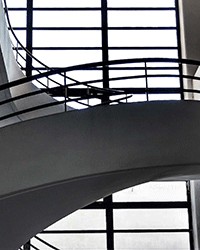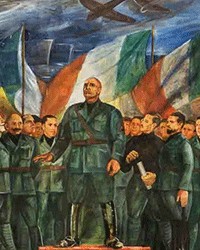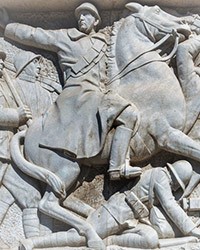It seems he desired to express himself in all styles, although late Renaissance and Baroque excited his imagination the most. He felt himself to be a direct successor of Michelangelo, Gian Lorenza Bernini and Francesco Borromini. However, although his designs were perfect for the city center, coming together with buildings from centuries past, on the outskirts they looked rather grotesque for some and strange for others. His contemporaries accused him of being more of a stucco sculptor than an architect, who should pay attention to function, location and adapting the building to its surroundings. However, this criticism, in the face of the will to create spectacular visions of the world of the past, full of monumental, theatrical and overflowing forms, simply bringing us to our knees, was of little interest to him. It should therefore, come as no surprise that his talents were used in shooting historical dramas of the time – he was the author of the scenery for such high-budget films as Quo Vadis (1923) and Theodora (1922).

He came from a poor family, had no connections in the Roman architectural community. He was a kind of a self-taught artist, who initially worked at decorating churches. His design of the fence and enterance to the Roman zoo (1909) exhibited features of mature Baroque, which however, brought him more criticism than renown. Even then he was accused of architectural anachronism and a tendency for exaggeration. Nevertheless, there were also admirers of his vision. It gained the approval of two popes, Benedict XV and Pius XI, and brought Brasini commissions for the construction of the Basilica of Sacro Cuore Immacolato di Maria (1823/39-1954) in the Pinciano district on the then outskirts of the city. The church planned with great splendor was to be a symbol of the strength of Catholicism in the time of conflicts of between the pope and the Italian state and it was to even equal St. Peter’s Basilica on the Vatican (San Pietro in Vaticano). It was created as some kind of vision of grandeur, set in the era of Seicento, which showed most of all in the design of the dome stretching out to over 60 meters. Unfortunately, financial problems in a decisive way changed the fate of this church, which was not finished until twenty years later. The principal victim of this was the aforementioned soaring dome, of which in truth only an tambour of imposing circumference remained, covered with a poor substitute of a dome. As a result the external body seems to be damaged, constituting a some kind of pompous construction. The plan of the structure itself was also simplified. However, even after all these changes the monumental interior full of niches, columns and cornices presents itself splendidly. It is especially obvious standing between fourteen enormous columns (12 meters high each), placed in accordance with giant order at the church enterance.
The next time Brasini caught the attention of the artistic world was with the design of the Italian Pavilion for the World Expo in Paris in 1925. In it he included a touch of that, which he would soon develop with great momentum, creating monumental structures. At the same time the architect worked on his own city villa (Villa Brasini), situated in the Roman district of Flaminio. Called Castellaccio (ugly castle), it constitutes a veritable conglomerate of styles, accompanied by a mini-park created in the style of Baroque. External walls of the building are adorned with ancient sculptures and architectural elements found during archeological works which were in large part supervised by Brasini himself.
This artist also enjoyed recognition of Benito Mussolini, who entrusted him with work in Italian colonies, including in the city of Tripoli. However Duce, who was thoroughly interested in architecture and saw in it a significant element of propaganda, either favored him entrusting him with the completion of important structures, or criticized him. For example, he believed that Brasini is “the only architect, who deserves, to have his hand leave a mark in the center of Rome.” However, when the artist built the Palazzo INAIL in the very heart of Rome, on one hand the dictator expressed his delight over the structure, which ideally fit in with the architecture of old Rome, on the other hand he criticized it. For him it was too passeist and not “fascist” enough in its ideal message. Duce’s opinion of it, which he expressed with typical for him nonchalance, several hours after he had personally congratulated the artist on his work, is well known. He claimed that, “this is a real accident which happened to the accident insurer”, which of course was a direct reference to what the building was destined for – the residence of the National Institute for Insurance against Accidents at Work.

However, Brasini was able to really express himself when he was entrusted with the Buon Pastore complex, situated on the city outskirts and being a culmination of the work of this artist, and also a combination of all possible styles and forms. The structure simply overwhelms with its size, grandeur and fantasy, even today attracting with is aura throngs of directors, who want to shoot films inside, mainly in the genre of horror. Initially it served the Congregation of the Sisters of Our Lady of Charity of the Good Shepherd, then it was used as a hospital (for 2 thousand patients) then a military sanatorium, while since in 1969 it has housed several schools. In the past it was to be a “holy citadel” enriched with courtyards, and a church in the central part, which occupies an area of 12 thousand square meters. Today deteriorating, bereft of towers, it awaits rediscovery, which will undoubtedly take place.

Apart from long-lasting projects of Brasini, an important part of his work is made up of unfinished designs, in which in an almost limitlessly generous way, the artist let his fantastic and even revolutionary ideas run wild. An example, is the design of the governmental Mole Littoria building, which was to tower over St Peter’s Basilica itself, or the urban arrangements of which the creation in the very center of the city was connected with the destruction of old urban fabric and replacing it with new buildings created in the fascist spirit, as was the case with the old spina and the structures surrounding it, which gave way to the via della Conciliazione. The idea, initially praised and accepted, was later heavily criticized by architects and engineers such as Vincenzo Fasolo, Enrico Del Debbio and Angelo Ugo Beretta. Under their influence Mussolini, who initially favored the project, halted its implementation. Brasini’s enthusiasm and many years of work found no fulfillment. The architect could not hide his ire, counting on acquiring another ambitious commission, which would be worthy, as he claimed, of the new Fascist era. His only “reward” was receiving the title of “accademico d’Italia”. Perhaps a consolation prize was also, this time a completed design – the last work of a the Fascist era – Ponte Flaminio on the Tiber, in the past dedicated to Mussolini himself. The monumental structure, was not finished until after the war and as soon as it was put into use it aroused the admiration of Romans with its theatrical arrangements.
Despite the fact that Brasini was still active after the war in academic circles, he was not able to acquire any significant commissions.
The most important structures of the architect:
- Fencing of the enterance to the Roman Zoo, 1909
- Sacro Cuore Immacolato di Maria na Piazza Euclide, 1923–1954
- Palazzo INAIL at via IV Novembre, 1928–1932
- Villa Brasini at via Flaminia, 1933
- Buon Pastore Complex at via di Bravetta 383, 1929–1943
- Ponte Flaminio, 1939–1951
Also see: Virtual trip - Brasini





























































